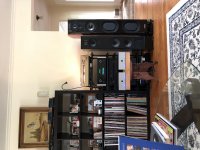ACA Kit Available
Ordered my ACA back in May, but couldn't wait, so I ordered the parts to build an F5. Have been so delighted with the F5, that I'm now building an M2x.
My ACA kit is being delivered on Monday, but I don't think I'm going to build it, now that I've stepped up to the First Watt amps.
Please PM me if you're interested in my ACA kit. Black front panel without power switch.
Ordered my ACA back in May, but couldn't wait, so I ordered the parts to build an F5. Have been so delighted with the F5, that I'm now building an M2x.
My ACA kit is being delivered on Monday, but I don't think I'm going to build it, now that I've stepped up to the First Watt amps.
Please PM me if you're interested in my ACA kit. Black front panel without power switch.
I've read where some forum members have had issues with the apparent lack of volume due to using inefficient speakers, not using a real preamp, or more likely (as in my case), both. As I'm using a laptop as a source, I found that I could just open up the equalizer in my media player and move up the "preamp" slider. When I did this my ACA really came alive (holy crap was the expression I believe I used) - even with the El-chEep-oh speekurz I'm using. Boy, is this a nice amp! And I'm actually ashamed I didn't think of this earlier.  Anyway, I figured this might help some of you until you're able to score one or both of the aforementioned goods.
Anyway, I figured this might help some of you until you're able to score one or both of the aforementioned goods.
I do beg your collective pardon if this has been mentioned before, but we're up to what, 5150 posts now? It's easy to overlook such things. My apologies also to those of you who, being a bit more sentient than me at the moment, have already figured this out.
BTW I'm using VLC player, which has a somewhat, er... let's be kind and call it kludgy... user interface. However, it seems to be able to provide better undistorted volume than iTunes. Either works to one extent or another, so pick yer poison.
Cheers!
-Mr_Zenith
 Anyway, I figured this might help some of you until you're able to score one or both of the aforementioned goods.
Anyway, I figured this might help some of you until you're able to score one or both of the aforementioned goods.I do beg your collective pardon if this has been mentioned before, but we're up to what, 5150 posts now? It's easy to overlook such things. My apologies also to those of you who, being a bit more sentient than me at the moment, have already figured this out.
BTW I'm using VLC player, which has a somewhat, er... let's be kind and call it kludgy... user interface. However, it seems to be able to provide better undistorted volume than iTunes. Either works to one extent or another, so pick yer poison.
Cheers!
-Mr_Zenith
Well, I finished soldering the PCBs. Obviously, being the obsessive guy I am I missed nothing nor failed in anything, but the orientation of the on of the transistors. Which one? No, of course not the ZTX450, but Q4 (which in my case read K370).



Unsoldering it was really tough, long, and, most critically HOTTTTT!!! I just hope I didn't fry the 'unobtainuim' JFET .
.
And it was the very last thing I soldered so that, by that point, I would have been proficient enough with the soldering iron to know how long to apply heat, how much solder to push through the hole. Everything was well thought of, except for the orientation. Damn it. Well, lets hope it didn't damage the part.
How you guys do all in just one day is mesmerizing. Really my hat off to all the people here, you are really efficient builders!
Best regards,
Rafa.
Unsoldering it was really tough, long, and, most critically HOTTTTT!!! I just hope I didn't fry the 'unobtainuim' JFET
And it was the very last thing I soldered so that, by that point, I would have been proficient enough with the soldering iron to know how long to apply heat, how much solder to push through the hole. Everything was well thought of, except for the orientation. Damn it. Well, lets hope it didn't damage the part.
How you guys do all in just one day is mesmerizing. Really my hat off to all the people here, you are really efficient builders!
Best regards,
Rafa.
Well, my "K170" actually read "K370" and the build guide made by 6L6 himself reads: "Q4 is the input Toshiba or LS Jfet, marked K370 or K170 on the flat of the package.".
So yeah, mine are of the 370 type (mine are from one of the kits distributed - I believe - in a Burning Amp and 6L6 was unbelievably kind and generous and sent them to me) .
So yeah, mine are of the 370 type (mine are from one of the kits distributed - I believe - in a Burning Amp and 6L6 was unbelievably kind and generous and sent them to me) .
Last edited:
6L6, do you think there is a chance it survived the long heating to unsolder it and resolder it the other way around?The K370 is a K170 in a slightly smaller package that is similar to TO-92, but proprietary to Toshiba.
It's absolutely the same silicon inside.
Thanks for everything.
6L6, do you think there is a chance it survived the long heating to unsolder it and resolder it the other way around?
Thanks for everything.
Rafa,
Whenever I run into these mishaps, especially with SMD components, I use Chip Quik which can be used with through hole components as well. Although it is a little messy, the component itself survives, since it introduces an alloy and lowers the melting point such that you can turn the temp down on your soldering iron and easily remove the component.
Something to think about:
Chip Quik - ChipQuik Alloy (10)
The video illustrates how easy it is...
I'll keep my fingers crossed for you...
Best,
Anand.
BA3 front end is good preamp.
So is a B1 with Korg triode.
Here's a really noob questions for people who know... read through the 1.5 guide up to step 42 about setting the bias, sounded easy enough. Watched the TekThing video and I realized he had powered the amp on before setting the bias. I know not these things, does the amp need to be on to set bias? When is the proper time to power it on and check that it even works? What are peoples thoughts on how, in TekThing, he let it warm up for 30 minutes before setting the bias?
Can i also assume that when its powered on, if one accidentally touched a capacitor that would be a really really bad thing?
Thanks
Can i also assume that when its powered on, if one accidentally touched a capacitor that would be a really really bad thing?
Thanks
Here's a really noob questions for people who know... read through the 1.5 guide up to step 42 about setting the bias, sounded easy enough. Watched the TekThing video and I realized he had powered the amp on before setting the bias. I know not these things, does the amp need to be on to set bias? When is the proper time to power it on and check that it even works? What are peoples thoughts on how, in TekThing, he let it warm up for 30 minutes before setting the bias?
Hi Azookey, yes the amp has to be on to measure the bias voltage, or there will not be a voltage on the test point to measure.
Maybe there needs to be step 42a. Something like - ''now have a drink of your choice, inspect the wiring and boards again and once you are happy plug in and switch on (no need for input or speakers at this stage)''.
You should measure the bias voltage when you first switch it on, as much to make sure all is well as anything else. Then set it roughly to half the supply voltage 10 /12 volts (10 volts for 19 volt supply and 12 volts for the 24 volt supply) and let it all warm up.
Check again after 5 or 10 minutes and adjust it closer to the 10 or 12 volt setting.
Note the bias will change with temperature, so you have to wait for the heatsinks to reach their stable temperature (not getting any hotter so 30 minutes or so) before making the final adjustment.
Now is the time to try it with speakers and music and enjoy.
Can i also assume that when its powered on, if one accidentally touched a capacitor that would be a really really bad thing?
Thanks
You could touch any part of the circuit (with a finger) without getting a shock. There is only 24 volts there. But Best Practice is not to.
Just take care when making measurements not to short anything with the meter probes or croc clips...
Alan
So with my pair of ML Motion 40's 92db at 4ohms, the bridged monoblocks are starting to open up. Seems it takes longer than a few hours to break them in. One minor concern the heat output measuring the heatsinks is steady at 135F in a 76F room once its up to temp. Normal?
I measured my heatsink yesterday after a couple of hours after power on. With an ambient temperature of 25 C (77 F) the heatsink was 48 - 49 C (119 F). That is so hot that you can still touch it but not very pleasant. But again I have only one ACA PCB pr stereo chassis to have room for large output caps etc. I run 1.4 A bias at 23.8 VDC.
6L6, do you think there is a chance it survived the long heating to unsolder it and resolder it the other way around?
Thanks for everything.
Hi Rafa,
Most likely it will be fine.
If you have a multimeter with a 'Diode' test on the ohms range you can check it out. (Use the Diode selection as most digital meters do not have enough voltage to allow 'conduction' on their normal ohms ranges.)
Black lead on G (gate) the meter should read Open Circuit with red lead to S (source) or D (drain). A reading or zero is bad.
Red lead on G the meter should give a reading with black to S or D. (Open or zero is bad.)
Red to S and black to D and red to D and black to S should both give a similar reading. Open or zero are bad.
Alan
Temporary setup McIntosh C47, ACA balanced monoblocks and Martin Logan Motion 40. Looking to put them in as set B with set A Polk LSiM707 powered by a Rotel RB-1590.
The ACA pair are really opening up and the somewhat efficient (92db) ML are able to pressurize the room.

The ACA pair are really opening up and the somewhat efficient (92db) ML are able to pressurize the room.
Attachments
Last edited:
- Home
- Amplifiers
- Pass Labs
- Amp Camp Amp - ACA




